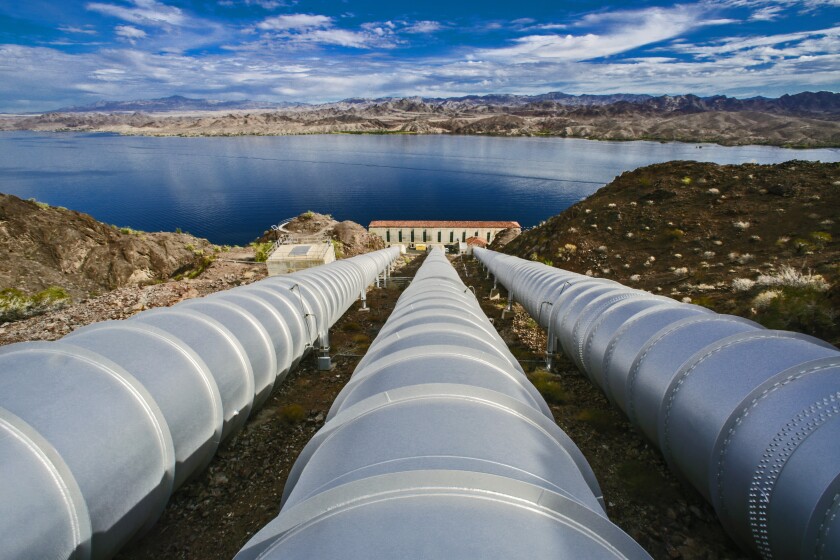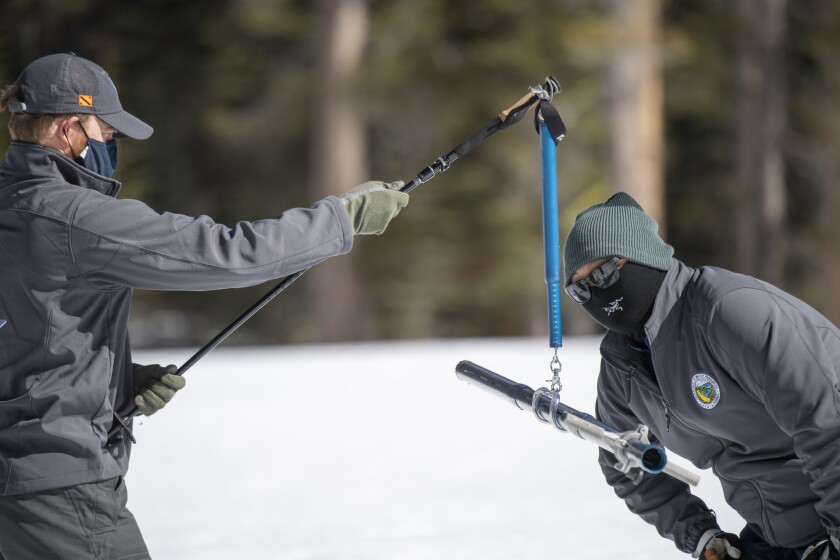This is the March 4, 2021, edition of Boiling Point, a weekly newsletter about climate change and the environment in California and the American West. Sign up here to get it in your inbox.
There’s a classic scene in “The Graduate” where Dustin Hoffman’s character, fresh out of college, gets pulled aside at a graduation party by a well-meaning friend of his parents and told: “I just want to say one word to you. Just one word ... plastics.”
If that scene were written today with sustainability in mind, the word might be “batteries.” Or maybe “hydrogen.”
But it might also be two words: “energy efficiency.”
Efficiency is not a newfangled concept, as you probably know if you’ve ever purchased an Energy Star-certified dishwasher or asked about the gas mileage of a car. Across the United States, per-person energy use has fallen since the 1970s even as overall demand has risen, according to the Energy Information Administration. The savings have been more dramatic in California, where state officials say aggressive efficiency standards for appliances and buildings have saved consumers well over $100 billion.
But there’s plenty more energy to be saved. And as often as I write about the importance of building clean power infrastructure to fight climate change, the cheapest, easiest way to reduce emissions is to use less energy in the first place.
And in Los Angeles, at least, one of the cheapest, easiest ways to use less energy is to use less water.
I’ll get to the new research in a minute. By way of background, it’s no secret the Golden State uses gobs of electricity to move water around. Just look at the State Water Project and the Central Valley Project, which carry Sierra Nevada snowmelt hundreds of miles from the rivers of the north to the farms and cities of the south, and the Colorado River Aqueduct, which brings additional water security to Southern California cities.
By one oft-cited (although out of date) estimate, nearly one-fifth of all electricity use in California goes to transporting and treating water. And nearly one-third of all natural gas use is water-related, primarily water heating.
There’s a bunch of research affirming the intuitive idea that energy savings result in water savings. But a new study out of UC Davis, published in the journal Environmental Research Letters, gives us much more detail on the potential.
Working with the Los Angeles Department of Water and Power, researchers compared what happens when LADWP pays people to use less electricity versus paying them to use less water, through appliance rebates and other financial incentives. The UC Davis team concluded that paying for water conservation can actually be a more cost-effective way to slash energy consumption than paying for energy conservation.
Here’s a chart from the study, showing the “levelized cost of saved energy” for various energy- and water-efficiency programs run by LADWP. The shorter the bar, the lower the cost of achieving the same energy savings. The orange bars represent actual energy-efficiency programs. The blue/green bars represent water-efficiency programs:

Ignore the second column for a moment. In the first one, we’re looking at energy consumed directly by LADWP, and also by L.A.'s sanitation department — all the pumps and treatment facilities owned and operated by the city, basically.
What we’re seeing is that although energy-efficiency programs are typically the cheapest way to save energy — those orange bars at the bottom are the shortest — several water-efficiency programs aren’t far behind. It costs the city 13 cents to save a kilowatt-hour of electricity by installing upgraded lighting, air conditioners and other efficiency fixes at schools, for instance. That’s just a penny less than it costs LADWP to save the same amount of electricity through rebates for rotating nozzle sprinkler heads.
Water-efficiency programs look even better for energy savings when you account for all the power used to transport the water across the state, and not just the power used by LADWP after the water reaches Los Angeles city limits.
That’s the second column in the chart. By this measure, sprinkler rebates now pencil out at 2 cents per kilowatt-hour of energy saved, with water-efficient toilet rebates coming in at 4 cents. That compares favorably to 7 cents for a refrigerator exchange program for low-income households and a whopping 90 cents for LADWP’s Home Energy Improvement Program.
State officials looking to reduce energy consumption — and thereby slash planet-heating emissions — ought to consider devoting a lot more money to water efficiency, says one of the study’s authors, UC Davis professor Ned Spang.
“We have significant statewide resources available year over year to invest in energy efficiency and to invest in greenhouse gas reduction, on the order of $1 billion a year for each,” Spang told me. “And we don’t have a similar statewide resource for water conservation. That’s really pushed down to the water utilities themselves.”

That’s problematic because water utilities are perpetually strapped for cash, a concern made worse by the COVID-19 pandemic. In California, about 1.6 million households were collectively $1 billion behind on their water bills as of January.
Another complicating factor is the tangled web of responsibility for California’s energy and water systems. Several entities are responsible for transporting water to Los Angeles, meaning LADWP itself doesn’t see the full energy-savings benefits of reducing its water use. State officials should develop strategies to get agencies and companies such as LADWP, Pacific Gas & Electric and the California Department of Water Resources to split costs and reduce energy and water use across the board, Spang said.
There are other nuances. Every city, town and irrigation district uses different amounts of energy to move water, based on their supply sources and their local topography. The energy savings will be larger for water utilities with far-flung supplies, and larger still if water use can be reduced in hilly neighborhoods specifically. And the ultimate goal is combating climate change, so saving water during times of year (or times of day) when there’s less clean electricity available could be especially valuable.
But there’s little question this is an important conversation to have, especially as California works to double its energy efficiency savings in electricity and natural gas by 2030, a mandate laid down by Senate Bill 350 in 2015.
And lest we forget, using less water is critically important in its own right. The planet is warming, and droughts are getting worse, straining already-limited supplies. Los Angeles Mayor Eric Garcetti set a goal of reducing per-person water use 25% by 2035.
So there’s a lot to be gained by switching out toilets, shower heads, light fixtures and air conditioners for more efficient models.
And somewhere, someone is whispering to Dustin Hoffman: “There’s a great future in energy efficiency. Think about it.”
Here’s what’s happening around the West:
TOP STORIES
Global carbon emissions fell by 7% in 2020 — now we just need to do that every year, without the economic devastation. My colleague Amina Khan reports on new research finding that meeting the goals of the Paris agreement will require near-pandemic-level carbon reductions every year this decade. The United Nations is looking at the problem from a slightly different angle, saying the world’s pledges thus far would only cut emissions by 1% total by 2030, as the AP’s Seth Borenstein reports.
In more encouraging news, Volvo pledged to sell only electric cars by 2030. That’s five years ahead of General Motors, in a sign there may be a virtuous cycle at work in the auto industry. Volvo says climate change “is the ultimate safety test,” as The Times’ Russ Mitchell reports. Cities are also trying new ideas to lessen dependence on gasoline. Here in Southern California, Santa Monica is “pricing the curb” with a one-square mile area downtown where electric vehicles will get priority parking, per Anne C. Mulkern at E&E News. And up north, Petaluma is banning new gas stations, Kathryn Palmer reports for the Argus-Courier.
Southern California’s water infrastructure is just as unprepared for the next big earthquake as Texas’ power grid was for the cold snap. I don’t typically include opinion pieces in this newsletter. But for Lucy Jones, the region’s preeminent earthquake expert, I’ll make an exception. She says the Los Angeles area needs to make major investments to harden its water system against the Big One, lest we want to spend many months without all that imported drinking water I was talking about earlier.
POLITICAL CLIMATE

The House of Representatives approved a bill that would protect 1.3 million acres of wilderness and 1,000 miles of wild and scenic rivers in the West. Here’s what I wrote last year about the Protecting America’s Wilderness Act, which would preserve lands in Southern California’s Santa Monica and San Gabriel mountains, if passed by the Senate and signed into law. The bill was part of a package that would also ban new uranium mining near the Grand Canyon, as the Arizona Republic’s Ian James reports.
House Democrats are setting the stage for climate action — depending on what can get through the Senate. A series of bills introduced this week would reshape oil and gas drilling on federal lands by raising royalty rates and requiring producers to slash methane emissions and set aside more money for cleanup; another bill would mandate 100% clean electricity nationwide by 2035, as Valerie Volcovici and Timothy Gardner report for Reuters. At the Interior Department, meanwhile, President Biden’s team isn’t waiting for Dab Haaland to be confirmed as secretary to get to work on climate, the New York Times’ Lisa Friedman reports.
Here’s an argument against a solar project I’d never heard before: It would disrupt the experience of viewing a remote piece of desert land art in Nevada. More details here from the Art Newspaper’s Gabriella Angeleti, but of course this is part of a larger phenomenon of local opposition to renewable energy facilities. Gizmodo’s Molly Taft writes about a new report out of Columbia University finding there are at least 100 ordinances in 31 states that make it harder to build wind or solar farms.
THE ENERGY TRANSITION
Renewable power sources generated more electricity than coal in the United States for the first time last year. Here’s the story from Dan Gearino at Inside Climate News. It’s a major milestone on the road to reduced emissions but not nearly sufficient to stem the climate crisis. Natural gas is still the country’s largest power source, generating about 40% of all electricity in 2020.
In San Diego — home to Sempra Energy, parent company of Southern California Gas and San Diego Gas & Electric — the city’s climate agenda does not include plans to ban gas in new buildings. Climate activists say that should be a priority for Mayor Todd Gloria, per the San Diego Union-Tribune’s Joshua Emerson Smith. There are similar fights playing out in Austin and San Antonio, Texas, where local gas companies are working hard behind the scenes to weaken plans to reduce dependence on gas, according to an investigation led by Floodlight, a new nonprofit news outlet founded by Emily Holden and focused on climate.
The International Code Council has proposed not letting government officials vote on its model building codes, which are used by cities across the United States. Climate advocates say home builders and the natural gas industry are pushing the move to slow progress on replacing gas furnaces and stoves with electric alternatives, as Alexander C. Kaufman reports for the Huffington Post. The Biden administration has weighed in, urging the council not to adopt any changes to its voting rules.
AROUND THE WEST

The start of a new month means a new snowpack reading in California’s Sierra Nevada, and the numbers aren’t good. The water content of the snowpack was 61% of average for March 2 and 54% of average for April 1, likely portending a critically dry year, my colleague Erin B. Logan reports. Elsewhere in the West, the table is being set for renegotiations on the Colorado River, with one key question being whether Native American tribes will finally get a full seat at the table, KUNC’s Luke Runyon reports.
Federal officials will help a wind energy company breed endangered California condors. There has never been a documented case of a wind turbine killing a condor. But in a unique effort to strike the right balance between clean energy and conservation, the U.S. Fish and Wildlife Service will work with Avangrid Renewables to breed several condors in captivity, to make up for any that might be killed by a wind farm the company plans to build in the Tehachapi Mountains, Louis Sahagún reports for The Times.
A wolf was spotted near Yosemite National Park for the first time in more than 100 years. A young male wolf journeying that far south is a major success story for efforts to reintroduce the gray wolf, which was hunted to extinction in California by the 1920s, per SFGATE’s Katie Dowd. There’s now at least one wolf pack in the state, although the wolf near Yosemite came from Oregon.
ONE MORE THING

Let’s close with two more wildlife stories. First, my colleague Jeanette Marantos reports that Western monarch butterfly numbers have fallen from 1.2 million during a Thanksgiving 1997 count to a staggeringly low 1,914 butterflies total this past year.
Second, The Times’ Hailey Branson-Potts reports that charmingly named horny toads — which are actually lizards — have virtually disappeared across vast swaths of Oklahoma and Texas, where they are beloved for their hardiness, their prehistoric appearance and their ability to shoot blood out of their eyes.
Climate change doesn’t appear to be the main culprit in either species’ struggle. Instead, the villains are habitat destruction due to human and agricultural sprawl, and toxic chemicals. Let this serve as a reminder that climate isn’t the only environmental crisis we face; the extinction crisis is another.
We’ll be back in your inbox next week. If you enjoyed this newsletter, please consider forwarding it to your friends and colleagues.
"save" - Google News
March 04, 2021 at 09:00PM
https://ift.tt/3uRj3A9
Want to save energy and fight climate change? Try using less water - Los Angeles Times
"save" - Google News
https://ift.tt/2SvBSrf
https://ift.tt/2zJxCxA
Bagikan Berita Ini















0 Response to "Want to save energy and fight climate change? Try using less water - Los Angeles Times"
Post a Comment